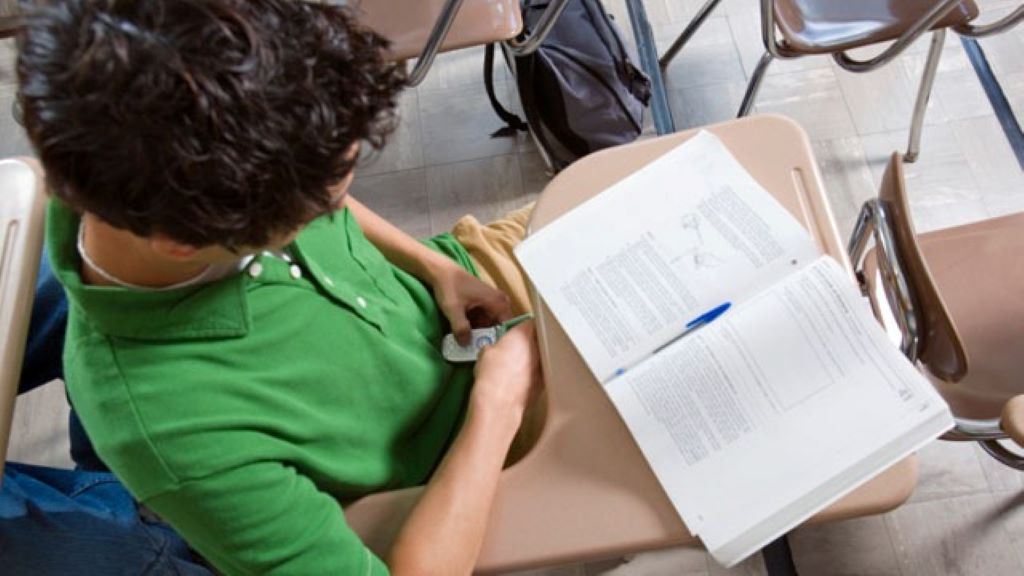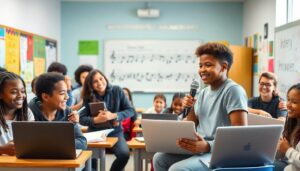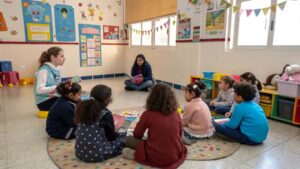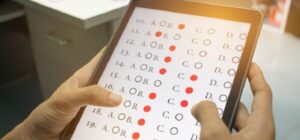Learners Most Affected by Digital Distractions
The shift to online learning has transformed education worldwide. However, this digital revolution has brought new challenges, particularly regarding student focus and attention. Research from Education Guide Blog shows that certain groups of learners face greater difficulties maintaining concentration in virtual environments than others.
Digital distractions have become a significant barrier to effective learning. Students now navigate social media notifications, streaming services, and countless online entertainment options while trying to focus on their studies. Understanding who is effected most my distrations with online learning helps educators and parents develop targeted support strategies. Additionally, identifying these vulnerable groups allows for better resource allocation and intervention programs.
The impact of digital distractions varies significantly across different demographics. Age, learning style, socioeconomic background, and technological familiarity all play crucial roles in determining susceptibility to online distractions. Therefore, addressing this issue requires a nuanced understanding of how various factors interact to create learning challenges.
Elementary School Students Face Unique Challenges
Young learners between ages 6-11 experience particular difficulties with digital distractions. Their developing brains struggle with impulse control and executive function skills. Consequently, elementary students often find it challenging to resist the temptation of games, videos, and other engaging online content during class time.
Furthermore, young children lack the metacognitive skills necessary to recognize when they’re becoming distracted. They may not understand the connection between their online activities and declining academic performance. This age group requires constant supervision and structured digital environments to maintain focus.
Teachers report that elementary students frequently multitask during virtual lessons. They might play mobile games, watch YouTube videos, or engage with social media platforms their parents allow them to use. However, their brains cannot effectively process multiple streams of information simultaneously, leading to reduced learning outcomes.
Middle School Students Navigate Social Pressures
Adolescents aged 11-14 face a particularly challenging combination of factors. Their increased independence coincides with heightened social awareness and peer pressure. Social media platforms become central to their identity formation, making it extremely difficult to ignore notifications and messages during online classes.
Moreover, middle school students experience significant emotional and hormonal changes. These biological shifts affect their ability to concentrate and make rational decisions about technology use. The fear of missing out (FOMO) intensifies during this developmental stage, creating additional pressure to stay constantly connected.
Peer influence plays a crucial role in distraction patterns among middle schoolers. Students often share gaming links, funny videos, and social media content during virtual classes. This behavior creates a cycle where distraction becomes normalized and even expected within their peer groups.
Students with Learning Differences Require Extra Support
Learners with ADHD, autism spectrum disorders, and other learning differences face amplified challenges in digital learning environments. Their neurological differences make them more susceptible to the constant stimulation provided by digital devices. Traditional classroom settings often provide structure and routine that help these students focus, but online learning removes many of these supportive elements.
Additionally, students with learning differences may struggle more with self-regulation skills. They require external support systems to manage their attention and behavior effectively. The home environment, while comfortable, may lack the professional accommodations and specialized support available in traditional classrooms.
Executive function challenges become more pronounced in digital learning settings. Students with these difficulties may struggle to organize their digital workspace, manage multiple browser tabs, or follow complex online instructions without becoming overwhelmed or distracted.

Socioeconomically Disadvantaged Students Experience Multiple Barriers
Students from lower-income families often face compound challenges with digital distractions. Limited access to reliable internet, shared devices among family members, and inadequate home learning spaces create additional stressors. These environmental factors increase susceptibility to distractions and reduce overall learning effectiveness.
Furthermore, parents in these households may work multiple jobs or lack the technological skills necessary to support their children’s online learning. Without proper supervision and guidance, students are more likely to engage with distracting content during school hours.
The digital divide also means these students may use older devices or unreliable internet connections. Technical difficulties can lead to frustration and disengagement, making students more likely to seek entertainment alternatives online rather than persisting with their academic work.
Generation Alpha Shows Different Distraction Patterns
Students born after 2010, known as Generation Alpha, demonstrate unique relationships with technology. Having grown up with smartphones and tablets from birth, they expect constant stimulation and immediate gratification. This expectation creates challenges when faced with traditional lecture formats or longer assignments requiring sustained attention.
These digital natives process information differently than previous generations. They’re accustomed to consuming bite-sized content and may struggle with longer-form educational materials. However, they also demonstrate remarkable multitasking abilities and technological fluency that can be leveraged for educational purposes.
Research from the Pew Research Center indicates that Generation Alpha students show different attention patterns compared to older generations. They may appear distracted by traditional standards but can effectively process information from multiple sources simultaneously when properly structured.
Rural Students Face Unique Technology Challenges
Students in rural areas encounter specific obstacles that increase their vulnerability to digital distractions. Limited internet bandwidth often means slower loading times for educational content, leading to frustration and the temptation to engage with lighter, more entertaining online content instead.
Additionally, rural students may have fewer technology support resources available. When technical issues arise during online classes, students might abandon their academic tasks in favor of more accessible digital entertainment options while waiting for assistance.
The isolation factor in rural communities also plays a role. Students may feel more disconnected from their classmates and teachers, making social media and gaming platforms more appealing as sources of social interaction and entertainment.
Effective Strategies for Supporting Vulnerable Learners
Educational institutions and families can implement several strategies to support students most affected by digital distractions. Creating structured online learning environments with clear expectations helps establish boundaries. Regular check-ins and interactive elements keep students engaged with academic content.
Technology tools can paradoxically help combat digital distractions. Browser extensions that block distracting websites, apps that limit social media access during school hours, and platforms designed specifically for educational purposes can create more focused learning environments.
Professional development for educators focusing on online engagement strategies proves essential. Teachers need training in recognizing signs of digital distraction and implementing intervention techniques specific to virtual learning environments.
Building Digital Citizenship Skills
Teaching students about responsible technology use becomes crucial in addressing digital distractions. Digital citizenship curricula should include lessons on time management, recognizing manipulation in online content, and understanding the impact of multitasking on learning outcomes.
Students benefit from learning metacognitive strategies that help them recognize when they’re becoming distracted. Self-monitoring techniques and reflection exercises can develop greater awareness of personal distraction patterns and triggers.
Creating positive peer pressure around focused learning helps counteract the normalization of distraction behaviors. Collaborative learning activities and study groups can redirect social energy toward academic goals rather than entertainment-focused interactions.
Conclusion
Digital distractions affect different groups of learners in varying ways and intensities. Elementary students struggle with impulse control, while middle schoolers navigate social pressures and identity formation. Students with learning differences require additional support structures, and socioeconomically disadvantaged learners face multiple barriers to success.
Understanding these differences allows educators, parents, and policymakers to develop targeted interventions. Rather than applying one-size-fits-all solutions, successful approaches must consider the unique challenges faced by each vulnerable population. Additionally, building digital citizenship skills and creating supportive learning environments remain essential strategies for all students.
The future of education depends on our ability to harness technology’s benefits while minimizing its distractive potential. Therefore, continued research and adaptation of teaching methods will be necessary as technology continues to evolve and shape learning experiences.
Frequently Asked Questions
What age group is most affected by digital distractions during online learning? Middle school students (ages 11-14) typically face the greatest challenges with digital distractions due to developmental factors, increased social awareness, and limited self-regulation skills combined with greater independence in device usage.
How do learning differences impact susceptibility to digital distractions? Students with ADHD, autism spectrum disorders, and other learning differences are more vulnerable to digital distractions because their neurological differences make them more sensitive to stimulation, and they often struggle with executive function skills needed for self-regulation.
What role does socioeconomic status play in digital distraction challenges? Lower-income students often face additional barriers including shared devices, unreliable internet, inadequate supervision, and stressful home environments that increase their susceptibility to seeking distraction through digital entertainment.
Are there specific signs that indicate a student is struggling with digital distractions? Common indicators include declining grades, difficulty completing assignments, frequent technical “issues” during class, limited participation in virtual discussions, and reports of multitasking during learning time.
What can parents do to help reduce digital distractions for their children? Parents can establish clear boundaries around device usage, create dedicated learning spaces, use parental controls and website blockers, maintain regular communication with teachers, and model appropriate technology habits themselves.
Read More:
Why Diversity on College Campuses Benefits the Students








